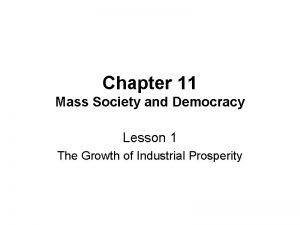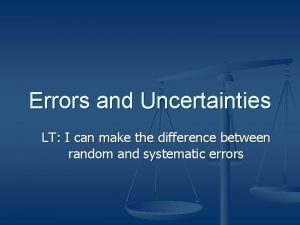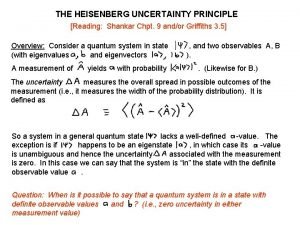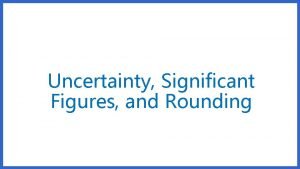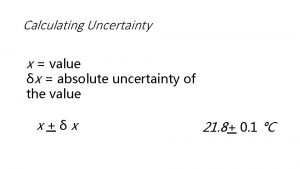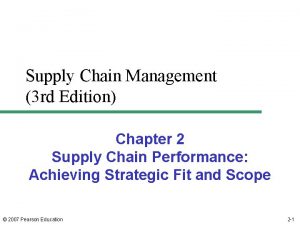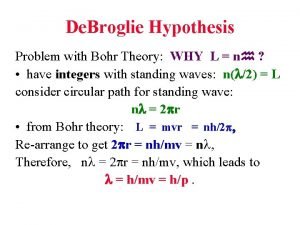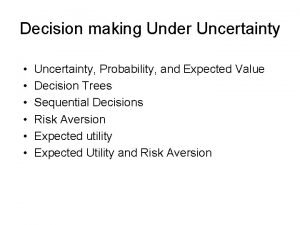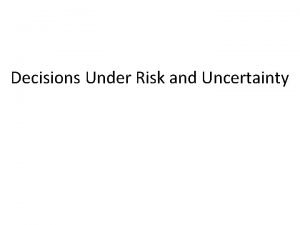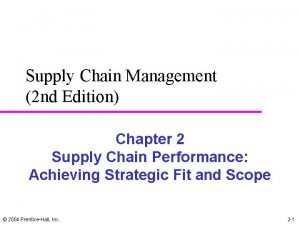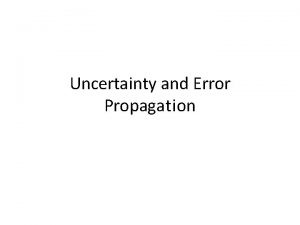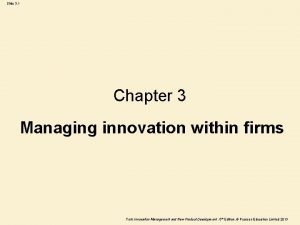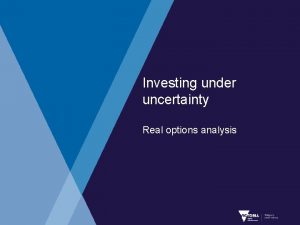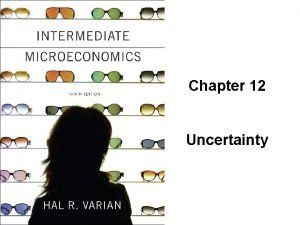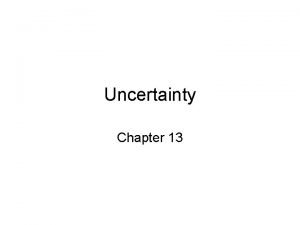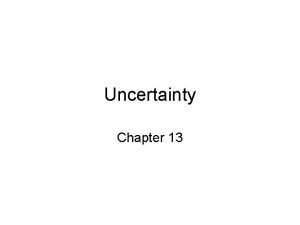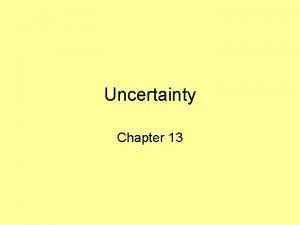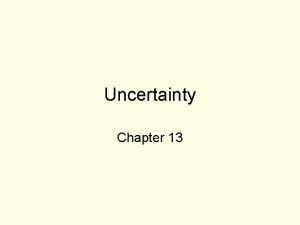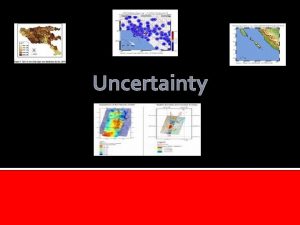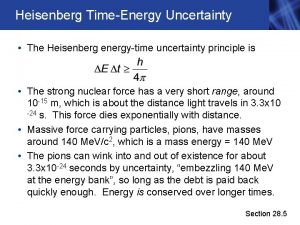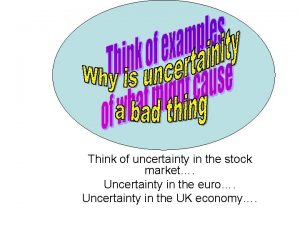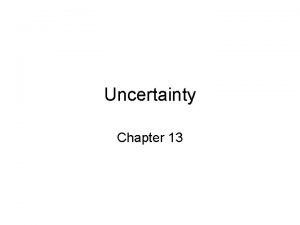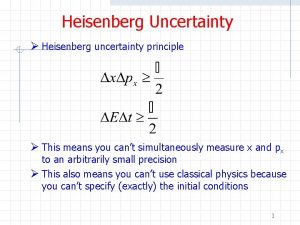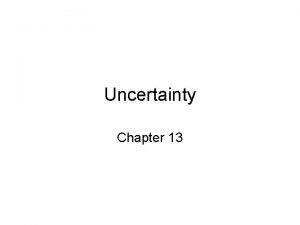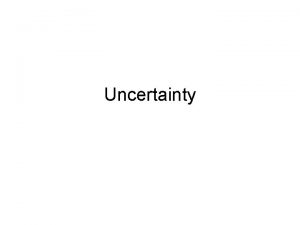Uncertainty Uncertainty n n n Uncertainty is a














- Slides: 14

Uncertainty

Uncertainty n n n Uncertainty is a situation which involves imperfect and/or unknown information. However, "uncertainty is an unintelligible expression without a straightforward description". It arises in subtly different ways in a number of fields, including insurance, philosophy, physics, statistics, economics, finance, psychology, sociology, engineering, metrology, and information science. It applies to predictions of future events, to physical measurements that are already made, or to the unknown. Uncertainty arises in partially observable and/or stochastic environments, as well as due to ignorance and/or indolence.

Uncertainty Handling n This is a traditional AI topic, but we need to cover it in at least a little detail here n n There are many different approaches to handling uncertainty n n prior to covering machine learning approaches Formal approaches based on mathematics (probabilities) Formal approaches based on logic Informal approaches Many questions arise n n How do we combine uncertainty values? How do we obtain uncertainty values? How do we interpret uncertainty values? How do we add uncertainty values to our knowledge and inference mechanisms?

Why Is Uncertainty Needed? n We will find none of the approaches to be entirely adequate so the natural question is why even bother? n Input data may be questionable n n n Knowledge may be questionable n n if I apply this piece of knowledge, does the conclusion necessarily hold true? associational knowledge for instance is not truth preserving, but used all the time in diagnosis Input may be ambiguous or unclear n n is this really a fact? Knowledge may not be truth-preserving n n to what extent is a patient demonstrating some symptom? do we rely on their word? this is especially true if we are dealing with real-world inputs from sensors, or dealing with situations where ambiguity readily exists (natural languages for instance) Output may be expected in terms of a plausibility/probability such as “what is the likelihood that it will rain today? ”

Methods to Handle Uncertainty n Fuzzy Logic n Logic that extends traditional 2 -valued logic to be a continuous logic (values from 0 to 1) n n Probabilistic Reasoning n n A variant of probabilistic reasoning where internal states are not observable (so they are called hidden) Certainty Factors and Qualitative Fuzzy Logics n n Using probabilities as part of the data and using Bayes theorem or variants to reason over what is most likely Hidden Markov Models n n while this early on was developed to handle natural language ambiguities such as “you are very tall” it instead is more successfully applied to device controllers More ad hoc approaches (non formal) that might be more flexible or at least more human-like Neural Networks n We will skip these in this lecture as we want to talk about NNs more with respect to learning

Reasoning n n n Reasoning system is a software system that generates conclusions from available knowledge using logical techniques such as deduction and induction. Reasoning systems play an important role in the implementation of artificial intelligence and knowledge-based systems. By the everyday usage definition of the phrase, all computer systems are reasoning systems in that they all automate some type of logic or decision. In typical use in the Information Technology field however, the phrase is usually reserved for systems that perform more complex kinds of reasoning. For example, not for systems that do fairly straightforward types of reasoning such as calculating a sales tax or customer discount but making logical inferences about a medical diagnosis or mathematical theorem. Reasoning systems come in two modes: interactive and batch processing. Interactive systems interface with the user to ask clarifying questions or otherwise allow the user to guide the reasoning process. Batch systems take in all the available information at once and generate the best answer possible without user feedback or guidance

MONOTONIC REASONING. n n n Traditional systems based on predicate logic are monotonic. Here number of statements known to be true increases with time. New statements are added and new theorems are proved, but the previously known statements never become invalid. In monotonic systems there is no need to check for in consistencies between new statements and the old knowledge. When a proof is made , the basis of the proof need not be remembered, since the old statements never disappear. But monotonic systems are not good in real problem domains where the information is incomplete, situations change and new assumptions are generated while solving new problems.

NONMONOTONIC REASONING. n n n Non monotonic reasoning is based on default reasoning or “most probabilistic choice”. S is assumed to be true as long as there is no evidence to the contrary. For example when we visit a friend’s home, we buy biscuits for the children. because we believe that most children like biscuits. In this case we do not have information to the contrary. A computational description of default reasoning must relate the lack of information on X to conclude on Y. Default reasoning ( or most probabilistic choice) is defined as follows: Definition 1 : If X is not known, then conclude Y. Definition 2 : If X can not be proved, then conclude Y. Definition 3: If X can not be proved in some allocated amount of time then conclude Y.

NONMONOTONIC REASONING(cont. . ) n n It is to be noted that the above reasoning process lies outside the realm of logic. It conclude on Y if X can not be proved, but never bothers to find whether X can be proved or not. Hence the default reasoning systems can not be characterized formally. Even if one succeeds in gaining complete information at the moment, the validity of the information may not be for ever, since it is a changing world. What appears to be true now, may be so at a later time ( in a non monotonic system). One way to solve the problem of a changing world to delete statements when they are no longer accurate, and replace them by more accurate statements. This leads to a non monotonic system in which statements can be deleted as well as added to the knowledge base. When a statement is deleted, other related statements may also have to be deleted.

NONMONOTONIC REASONING(cont. . ) n n n Non monotonic reasoning systems may be necessary due to any of the following reasons. The presence of incomplete inforamtio 0 n requires default reasoning. A changing world must be described by a changing database. Generating a complete solution to a problem may require temporary assumptions about partial solutions.

NONMONOTONIC REASONING(cont. . ) n Non monotonic system are harder to deal with than monotonic systems. This is because when a statement is deleted as “ no more valid”, other related statements have to be backtracked and they should be either deleted or new proofs have to be found for them. This is called dependency directed backtracking (DDB). In order to propagate the current changes into the database, the statements on which a particular proof depends, should also be stored along with the proof. Thus non – monotonic systems require more storage space as well as more processing time than monotonic systems.

STATISTICAL AND PROBABILISTIC REASONING n So far we have considered something being ‘true’ or ‘ not true ‘ or ‘not known’. there is also the situation ‘probably true’. In situations where “the relevant world is random” or “appears to be random because of poor representation “ or “not random but our program can not access large data base”, probabilistic reasoning is to be applied. (Example of such situations are – motion of electron, a drug being successful on a patient etc, ). One has to apply probabilistic reasoning in deciding about the next card to play in a game of cards or in diagnosing the illness from the symptoms. These are random world. Uncertainties can arise from an inability to predict outcomes due to unreliable, vague, incomplete or inconsistent knowledge.

Probabilistic reasoning n n n Probabilistic reasoning is using logic and probability to handle uncertain situations. An example of probabilistic reasoning is using past situations and statistics to predict an outcome. Probabilistic reasoning Problem-solving techniques based on the use of probability theory for weighing evidence and inferring conclusions. The aim of a probabilistic logic (also probability logic and probabilistic reasoning) is to combine the capacity of probability theory to handle uncertainty with the capacity of deductive logic to exploit structure of formal argument. Probabilistic logics attempt to find a natural extension of traditional logic truth tables: the results they define are derived through probabilistic expressions instead. A difficulty with probabilistic logics is that they tend to multiply the computational complexities of their probabilistic and logical components. Other difficulties include the possibility of counter-intuitive results, such as those of Dempster-Shafer theory.

FUZZY LOGIC n In fuzzy logic, we consider what happens if we make fundamental changes to our idea of set membership and corresponding changes to our definitions of logical operations. While traditional set-theory defines set membership as a Boolean predicate, fuzzy set theory allows us to represent set membership as a possibility distribution such as tall-very for the set of tall people and the set of very tall people. This contrasts with the standard Boolean definition for tall people where one is either tall or not and there must be a specific height that defines the boundary. The same is true for very tall. In fuzzy logic, one’s tallness increases with one’s height until the value 1 is reached. So it is a distribution. Once set membership has been redefined in this way, it is possible to define a reasoning system based on techniques for combining distributions. Such reasoners have been applied in control systems for devices as diverse as trains and washing machines.
 Chapter 13 mass society and democracy
Chapter 13 mass society and democracy Triple beam balance uncertainty
Triple beam balance uncertainty Ehrenfest theorem
Ehrenfest theorem Scientific figures
Scientific figures Absolute uncertainty equation
Absolute uncertainty equation Implied demand uncertainty in supply chain management
Implied demand uncertainty in supply chain management Heisenberg uncertainty principle statement
Heisenberg uncertainty principle statement Expected profit under uncertainty
Expected profit under uncertainty Uncertainty vs risk
Uncertainty vs risk Intraoperation scope
Intraoperation scope Error propagation formula
Error propagation formula Error of propagation
Error of propagation Managing innovation within firms
Managing innovation within firms Is it real issue with genuine controversy and uncertainty
Is it real issue with genuine controversy and uncertainty Risk versus uncertainty
Risk versus uncertainty
